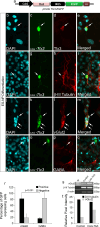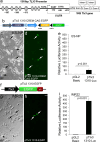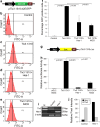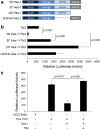Hes-1 regulates the excitatory fate of neural progenitors through modulation of Tlx3 (HOX11L2) expression
- PMID: 21744064
- PMCID: PMC11114997
- DOI: 10.1007/s00018-011-0765-8
Hes-1 regulates the excitatory fate of neural progenitors through modulation of Tlx3 (HOX11L2) expression
Abstract
Tlx3 (HOX11L2) is regarded as one of the selector genes in excitatory versus inhibitory fate specification of neurons in distinct regions of the nervous system. Expression of Tlx3 in a post-mitotic immature neuron favors a glutamatergic over GABAergic fate. The factors that regulate Tlx3 have immense importance in the fate specification of glutamatergic neurons. Here, we have shown that Notch target gene, Hes-1, negatively regulates Tlx3 expression, resulting in decreased generation of glutamatergic neurons. Down-regulation of Hes-1 removed the inhibition on Tlx3 promoter, thus promoting glutamatergic differentiation. Promoter-protein interaction studies with truncated/mutated Hes-1 protein suggested that the co-repressor recruitment mediated through WRPW domain of Hes-1 has contributed to the repressive effect. Our results clearly demonstrate a new and unique role for canonical Notch signaling through Hes-1, in neurotransmitter/subtype fate specification of neurons in addition to its known functional role in proliferation/maintenance of neural progenitors.
Figures







Similar articles
-
Tlx3 promotes glutamatergic neuronal subtype specification through direct interactions with the chromatin modifier CBP.PLoS One. 2015 Aug 10;10(8):e0135060. doi: 10.1371/journal.pone.0135060. eCollection 2015. PLoS One. 2015. PMID: 26258652 Free PMC article.
-
ATF2 maintains a subset of neural progenitors through CBF1/Notch independent Hes-1 expression and synergistically activates the expression of Hes-1 in Notch-dependent neural progenitors.J Neurochem. 2010 May;113(4):807-18. doi: 10.1111/j.1471-4159.2010.06574.x. Epub 2010 Jan 8. J Neurochem. 2010. PMID: 20067572
-
Expression dynamics and functions of Hes factors in development and diseases.Curr Top Dev Biol. 2014;110:263-83. doi: 10.1016/B978-0-12-405943-6.00007-5. Curr Top Dev Biol. 2014. PMID: 25248479 Review.
-
Tlx3 and Tlx1 are post-mitotic selector genes determining glutamatergic over GABAergic cell fates.Nat Neurosci. 2004 May;7(5):510-7. doi: 10.1038/nn1221. Epub 2004 Apr 4. Nat Neurosci. 2004. PMID: 15064766
-
Roles of Hes genes in neural development.Dev Growth Differ. 2008 Jun;50 Suppl 1:S97-103. doi: 10.1111/j.1440-169X.2008.00993.x. Epub 2008 Apr 22. Dev Growth Differ. 2008. PMID: 18430159 Review.
Cited by
-
Membrane translocation of t-SNARE protein syntaxin-4 abrogates ground-state pluripotency in mouse embryonic stem cells.Sci Rep. 2017 Jan 6;7:39868. doi: 10.1038/srep39868. Sci Rep. 2017. PMID: 28057922 Free PMC article.
-
MiRNA influences in mesenchymal stem cell commitment to neuroblast lineage development.Noncoding RNA Res. 2018 Nov 15;3(4):232-242. doi: 10.1016/j.ncrna.2018.11.002. eCollection 2018 Dec. Noncoding RNA Res. 2018. PMID: 30533571 Free PMC article.
-
Hes1: the maestro in neurogenesis.Cell Mol Life Sci. 2016 Nov;73(21):4019-42. doi: 10.1007/s00018-016-2277-z. Epub 2016 May 27. Cell Mol Life Sci. 2016. PMID: 27233500 Free PMC article. Review.
-
Regulation of Tlx3 by Pax6 is required for the restricted expression of Chrnα3 in Cerebellar Granule Neuron progenitors during development.Sci Rep. 2016 Jul 25;6:30337. doi: 10.1038/srep30337. Sci Rep. 2016. PMID: 27452274 Free PMC article.
-
miR Cluster 143/145 Directly Targets Nrl and Regulates Rod Photoreceptor Development.Mol Neurobiol. 2017 Dec;54(10):8033-8049. doi: 10.1007/s12035-016-0237-0. Epub 2016 Nov 23. Mol Neurobiol. 2017. PMID: 27878762
References
Publication types
MeSH terms
Substances
LinkOut - more resources
Full Text Sources
Research Materials

